SBI PO - Animal Kingdom 1000+ MCQ [Solved] PDF Download
Thursday 9th of March 2023

Sharing is caring
1. Which one of the following features is common in silverfish, scorpion, dragonfly and prawn?
A. Three pairs of legs and segmented body.
B. Chitinous cuticle and two pairs of antennae.
C. Jointed appendages and chitinous exoskeleton.
D. Cephalothorax and tracheae.
Answer : C
A. Three pairs of legs and segmented body.
B. Chitinous cuticle and two pairs of antennae.
C. Jointed appendages and chitinous exoskeleton.
D. Cephalothorax and tracheae.
Answer : C
2. Match the organisms given in column-I with their common name given in column-II and choose the correct option.
A. A II; C III; D I; E IV
B. A II; C IV; D I; E III
C. A II; C I; D III; E IV
D. A II; C I; D III; E IV
Answer : C
| Column -I | Column -II |
|---|---|
| (Organisms) | (Comman name) |
| A. Pennatula | I. Sea-lily |
| B. Antedon | II. Sea- pen |
| C. Echinus | III. Sea-urchin |
| D. Cucumaria | IV. Sea - cucumber |
A. A II; C III; D I; E IV
B. A II; C IV; D I; E III
C. A II; C I; D III; E IV
D. A II; C I; D III; E IV
Answer : C
3. Few cnidarians like corals have a skeleton composed of
A. calcium hydroxide
B. calcium sulphate
C. calcium carbonate
D. sodium bicarbonate
Answer : C
A. calcium hydroxide
B. calcium sulphate
C. calcium carbonate
D. sodium bicarbonate
Answer : C
4. Refer the figures A, B and C and choose the correct option which shows animals that regulate buoyancy with the help of air bladder.
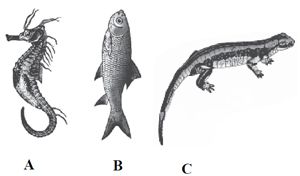
A. A and B
B. A and C
C. B and C
D. All of the above.
Answer : A

A. A and B
B. A and C
C. B and C
D. All of the above.
Answer : A
5. Which of the following group of animals reproduces only by sexual means?
A. Ctenophora
B. Cnidaria
C. Porifera
D. Protozoa
Answer : A
A. Ctenophora
B. Cnidaria
C. Porifera
D. Protozoa
Answer : A
6. Which of the following characteristic distinguish arthropoda from annelids and molluscs ?
A. An external skeleton made of chitin (a polysaccharide) and protein rather than a shell made chiefly of mineral salts.
B. Subdivision of the legs into movable segments.
C. Distinct group of muscles, derived from many body segments, that move the separate parts of the exoskeleton.
D. All of the above
Answer : D
A. An external skeleton made of chitin (a polysaccharide) and protein rather than a shell made chiefly of mineral salts.
B. Subdivision of the legs into movable segments.
C. Distinct group of muscles, derived from many body segments, that move the separate parts of the exoskeleton.
D. All of the above
Answer : D
7. Which of the following statements is without exception in sponges ?
A. They all have calcareous spicules.
B. They have high regenerative power.
C. They are found only in marine water.
D. They are all radially symmetrical.
Answer : B
A. They all have calcareous spicules.
B. They have high regenerative power.
C. They are found only in marine water.
D. They are all radially symmetrical.
Answer : B
8. Which of the following statement(s) is/are correct regarding class aves?
(i) The forelimbs are modified into wings and the hindlimbs generally have scales and are modified for walking, swimming or clasping the tree branches.
(ii) Heart is completely four-chambered.
(iii) They are warm- blooded (homoiothermous) animals i.e., they are able to maintain a constant body temperature.
(iv) They are oviparous and development is direct.
A. Both (i) and (iii)
B. Both (i) and (iv)
C. (i), (ii) and (iii)
D. All of these
Answer : D
(i) The forelimbs are modified into wings and the hindlimbs generally have scales and are modified for walking, swimming or clasping the tree branches.
(ii) Heart is completely four-chambered.
(iii) They are warm- blooded (homoiothermous) animals i.e., they are able to maintain a constant body temperature.
(iv) They are oviparous and development is direct.
A. Both (i) and (iii)
B. Both (i) and (iv)
C. (i), (ii) and (iii)
D. All of these
Answer : D
9. Which of the following statements is incorrect ?
A. Prawn has two pairs of antennae.
B. Nematocysts are characteristic feature of the phylum cnidaria.
C. Millipedes have two pairs of appendages in each segment of the body.
D. Animals that belong to phylum porifera are exclusively marine.
Answer : D
A. Prawn has two pairs of antennae.
B. Nematocysts are characteristic feature of the phylum cnidaria.
C. Millipedes have two pairs of appendages in each segment of the body.
D. Animals that belong to phylum porifera are exclusively marine.
Answer : D
10. Which of the following characteristics is correct for reptilia?
A. Body covered with dry and cornified skin, scales over the body are epidermal, they do not have external ears.
B. Body is covered with moist skin and is devoid of scales, the ear is represented by a tympanum, alimentary canal, urinary and reproductive tracts open into a common cloaca.
C. Fresh water animals with bony endoskeleton and airbladder regulate buoyancy.
D. Marine animals with cartilaginous endoskeleton and body is covered with placoid scales.
Answer : A
A. Body covered with dry and cornified skin, scales over the body are epidermal, they do not have external ears.
B. Body is covered with moist skin and is devoid of scales, the ear is represented by a tympanum, alimentary canal, urinary and reproductive tracts open into a common cloaca.
C. Fresh water animals with bony endoskeleton and airbladder regulate buoyancy.
D. Marine animals with cartilaginous endoskeleton and body is covered with placoid scales.
Answer : A
11. The given figures of animals (A & B) are distinguished on the basis of symmetry. Select the correct option which shows the type of symmetry and its description against the animals.
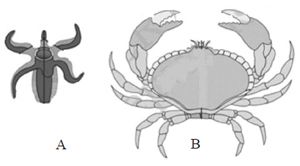
A. A : Biradial, organisms is divided into unequal halves by any plane through the central axis.
B. B: Bilateral, body is divided into equivalent right and left halves by only one plane.
C. A: Asymmetrical, organisms is not divided into equal halves by any plane through the central axis.
D. B: Radial, in which any plane passing through the central axis of the body divides the organism into two identical halves.
Answer : B

A. A : Biradial, organisms is divided into unequal halves by any plane through the central axis.
B. B: Bilateral, body is divided into equivalent right and left halves by only one plane.
C. A: Asymmetrical, organisms is not divided into equal halves by any plane through the central axis.
D. B: Radial, in which any plane passing through the central axis of the body divides the organism into two identical halves.
Answer : B
12. Which of the following animal's body is covered by calcareous shell and unsegmented with a distinct head, muscular foot, and visceral hump?
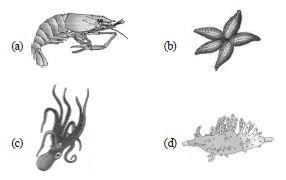
A. Click to check answer
B. Click to check answer
C. Click to check answer
D. Click to check answer
Answer : C

A. Click to check answer
B. Click to check answer
C. Click to check answer
D. Click to check answer
Answer : C
13. In phylum arthropoda, excretion takes place through
A. nephridia
B. flame cells
C. malphigian tubules
D. gills
Answer : C
A. nephridia
B. flame cells
C. malphigian tubules
D. gills
Answer : C
14. Which one of the following categories of animals is correctly described with no single exception in it?
A. In chondrichthyes notochord is persistent throughout life.
B. All mammals are viviparous and possess diaphragm for breathing.
C. All sponges are marine.
D. All reptiles possess scales, have a three chambered heart and are cold blooded (poikilothermal).
Answer : A
A. In chondrichthyes notochord is persistent throughout life.
B. All mammals are viviparous and possess diaphragm for breathing.
C. All sponges are marine.
D. All reptiles possess scales, have a three chambered heart and are cold blooded (poikilothermal).
Answer : A
15. Which of the following is not a chordate character?
A. Presence of paired pharyngeal gill slits
B. Ventral heart
C. Solid and ventral nerve cord
D. Presence of post-anal tail
Answer : C
A. Presence of paired pharyngeal gill slits
B. Ventral heart
C. Solid and ventral nerve cord
D. Presence of post-anal tail
Answer : C
16 Which of the following is a correct match of a phylum with their three examples?
A. PlatyhelminthesPlanaria, Schistosoma, Enterobius
B. Mollusca Loligo, Sepia, Octopus
C. Porifera Spongilla, Euplectella, Pennatula
D. Cnidaria Bonellia, Physalia, Aurelia
Answer : B
A. PlatyhelminthesPlanaria, Schistosoma, Enterobius
B. Mollusca Loligo, Sepia, Octopus
C. Porifera Spongilla, Euplectella, Pennatula
D. Cnidaria Bonellia, Physalia, Aurelia
Answer : B
17. Which of the following characteristic is probably most responsible for the great diversification of insects on land ?
A. Segmentation
B. Antennae
C. Bilateral symmetry
D. Exoskeleton
Answer : D
A. Segmentation
B. Antennae
C. Bilateral symmetry
D. Exoskeleton
Answer : D
18. Aquatic annelids (like Nereis) possess lateral appendages called ______________, which help in swimming.
A. visceral hump
B. parapodia
C. radula
D. spicules
Answer : B
A. visceral hump
B. parapodia
C. radula
D. spicules
Answer : B
19. Identify the figures and select the correct option
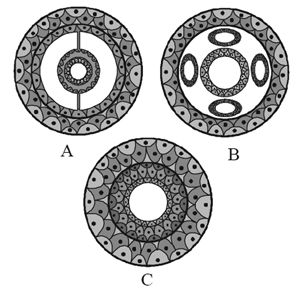
A. A - Pseudocoelomate; B - Coelomate, C-Acoelomate
B. A - Coelomate, B - Pseudocoelomate, C- Acoelomate
C. A - Coelomate; B- Acoelomate; C - Pseudocoelomate
D. A - Coelomate; B- Acoelomate; C-Eucoelomate
Answer : B

A. A - Pseudocoelomate; B - Coelomate, C-Acoelomate
B. A - Coelomate, B - Pseudocoelomate, C- Acoelomate
C. A - Coelomate; B- Acoelomate; C - Pseudocoelomate
D. A - Coelomate; B- Acoelomate; C-Eucoelomate
Answer : B
20. Refer the following statement and answer the question. 'Name of X is derived from stinging capsules. It exhibits metagenesis containing two body forms in which sessile and cylindrical form is called Y and umbrella shaped and free swimming is called Z. Identify X, Y, and Z.
A. X - Coelenterate, Y - Polyp, Z - Medusa
B. X - Cnidarian, Y - Medusa, Z - Polyp
C. X - Ctenophora, Y - Radula, Z - Hypostome
D. X - Porifera, Y - Osculum, Z - Radula
Answer : A
A. X - Coelenterate, Y - Polyp, Z - Medusa
B. X - Cnidarian, Y - Medusa, Z - Polyp
C. X - Ctenophora, Y - Radula, Z - Hypostome
D. X - Porifera, Y - Osculum, Z - Radula
Answer : A
21. A student brought home a strange animal which he found outside under a rock. It had moist skin, a complete digestive tract, a ventral nerve cord, and had gone through torsion. Identify the phylum of the animal.
A. Porifera
B. Annelida
C. Mollusca
D. Echinodermata
Answer : B
A. Porifera
B. Annelida
C. Mollusca
D. Echinodermata
Answer : B
22. The figure given below is the characteristic structure of the phylum in which animals are aquatic, free swimming or sessile, mostly marine, radially symmetrical. Identify the phylum and correct function of the structure.

A. Ctenophora; Emission of light.
B. Porifera; Feeding, respiration and excretion.
C. Cnidarian; Anchorage, Defense and food capturing
D. Mollusca; Locomotion, transport of food and respiration.
Answer : C

A. Ctenophora; Emission of light.
B. Porifera; Feeding, respiration and excretion.
C. Cnidarian; Anchorage, Defense and food capturing
D. Mollusca; Locomotion, transport of food and respiration.
Answer : C
23. Which of the follwoing statement(s) is/are correct?
(i) Organ systems in different group of animals show various patterns of complexities.
(ii) The digestive system in platyhelminthes has only a single opening to the outside of the body that serve as both mouth and anus, and is hence called complete.
(iii) In open type of circulatory system, the blood is pumped out of the heart and the cells and tissues are directly bathed in it.
(iv) In closed type, the blood is circulated through a series of vessels of varying diameters (arteries, veins and capillaries).
A. Only (i)
B. Both (ii) and (iii)
C. (i), (iii) and (iv)
D. All of these
Answer : C
(i) Organ systems in different group of animals show various patterns of complexities.
(ii) The digestive system in platyhelminthes has only a single opening to the outside of the body that serve as both mouth and anus, and is hence called complete.
(iii) In open type of circulatory system, the blood is pumped out of the heart and the cells and tissues are directly bathed in it.
(iv) In closed type, the blood is circulated through a series of vessels of varying diameters (arteries, veins and capillaries).
A. Only (i)
B. Both (ii) and (iii)
C. (i), (iii) and (iv)
D. All of these
Answer : C
24. In phylum echinodermata, the adult echinoderms are ______A__________ but larvae are _______B______ .
A. A radially symmetrical; B bilaterally symmetrical
B. A bilaterally symmetrical; B radially symmetrical
C. A bilaterally symmetrical; B asymmetrical
D. A metamerically segmented; B asymmetrical
Answer : A
A. A radially symmetrical; B bilaterally symmetrical
B. A bilaterally symmetrical; B radially symmetrical
C. A bilaterally symmetrical; B asymmetrical
D. A metamerically segmented; B asymmetrical
Answer : A
25. The given figures A, B, C and D are the examples of first true land vertebrates. They are dominant in mesozoic era and belong to phylum ‘X’. Identify ‘X’ and the animals which have four chambered heart.
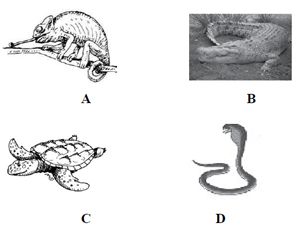
A. X – Reptile; B
B. X – Reptile; A
C. X – Amphibia, C
D. X – Pisces; D
Answer : A

A. X – Reptile; B
B. X – Reptile; A
C. X – Amphibia, C
D. X – Pisces; D
Answer : A
26. Which of the following is not a characteristic feature of kingdom animalia ?
A. Storage of carbohydrates as starch.
B. Multicellularity.
C. Obtaining nutrients by ingestion.
D. Having eukaryotic cells without walls.
Answer : A
A. Storage of carbohydrates as starch.
B. Multicellularity.
C. Obtaining nutrients by ingestion.
D. Having eukaryotic cells without walls.
Answer : A
27. Which of the following traits is not shared by both sea anemones and jellyfish ?
A. A medusa as the dominant stage in the life cycle.
B. Possession of a gastro vascular cavity.
C. Sexual reproduction.
D. Nematocysts present on the tentacles.
Answer : A
A. A medusa as the dominant stage in the life cycle.
B. Possession of a gastro vascular cavity.
C. Sexual reproduction.
D. Nematocysts present on the tentacles.
Answer : A
28. Match the terms/feature given in column I with their examples given in column II and select the correct match from the option given below.
A. A - i, B - ii, C - iii, D - iv, E - v
B. A - iii, B - v, C - ii, D - iv, E - i
C. A - iii, B - i, C - v, D - ii, E - iv
D. A - v, B - iv, C - iii, D - i, E - ii
Answer : D
| Column-I | Column-II |
|---|---|
| (Term/Feature) | (Examples) |
| A. Gregarious pest | i. Hirudinaria |
| B. Vector | ii. Planaria |
| C. Oviparous with | iii. Sepia indirect development |
| D. Metameres | iv. Aedes |
| E. High regeneration | v. Locust capacity |
A. A - i, B - ii, C - iii, D - iv, E - v
B. A - iii, B - v, C - ii, D - iv, E - i
C. A - iii, B - i, C - v, D - ii, E - iv
D. A - v, B - iv, C - iii, D - i, E - ii
Answer : D
29. Which of the following sets of animals give birth to young ones?
A. Platypus, Penguin, Bat, Hippopotamus.
B. Shrew, Bat, Cat, Kiwi.
C. Kangaroo, Hedgehog, Dolphin, Loris.
D. Lion, Bat, Whale, Ostrich.
Answer : C
A. Platypus, Penguin, Bat, Hippopotamus.
B. Shrew, Bat, Cat, Kiwi.
C. Kangaroo, Hedgehog, Dolphin, Loris.
D. Lion, Bat, Whale, Ostrich.
Answer : C
30. Which of the following statement(s) is/are correct regarding phylum coelenterata?
(i) They are aquatic, mostly marine, sessile or freeswimming, radially symmetrical animals.
(ii) They have a central gastro-vascular cavity with a single opening called hypostome.
(iii) Digestion is extracellular and intracellular.
(iv) Examples are Sycon, Spongilla and Euspongia.
A. (i) and (ii)
B. (i) and (iv)
C. (i), (ii) and (iii)
All of these
Answer : C
(i) They are aquatic, mostly marine, sessile or freeswimming, radially symmetrical animals.
(ii) They have a central gastro-vascular cavity with a single opening called hypostome.
(iii) Digestion is extracellular and intracellular.
(iv) Examples are Sycon, Spongilla and Euspongia.
A. (i) and (ii)
B. (i) and (iv)
C. (i), (ii) and (iii)
Answer : C
31. Which of the following pairs of animals are similar to each other pertaining to the feature stated against them?
A. Pteropus and Ornithorhyncus - Viviparity
B. Garden lizard and crocodile - Three chambered heart
C. Ascaris and Ancylostoma - Metameric segmentation
D. Sea horse and flying fish - Cold blooded (poikilothermal)
Answer : D
A. Pteropus and Ornithorhyncus - Viviparity
B. Garden lizard and crocodile - Three chambered heart
C. Ascaris and Ancylostoma - Metameric segmentation
D. Sea horse and flying fish - Cold blooded (poikilothermal)
Answer : D
32. Column-I contains organisms and column-II contains their exeretory structures. Choose the correct match form the options given below.
A. A I; B III; C II; D IV; E V
B. A III; B I; C II; D V; E IV
C. A II; B I; C III; D V; E IV
D. A II; B III; C I; D V; E IV
Answer : D
| Column- I | Column -II |
|---|---|
| (Organism) | (Excretory structures) |
| A. Cockroach | I. Nephridia |
| B. Cat fish | II. Malpighian tubules |
| C. Earthworm | III. Kidneys |
| D. Balanoglossus | IV. Flame cells |
| E. Flatworm | V. Proboscis gland |
A. A I; B III; C II; D IV; E V
B. A III; B I; C II; D V; E IV
C. A II; B I; C III; D V; E IV
D. A II; B III; C I; D V; E IV
Answer : D
33. Heart is three - chambered in reptiles, except
A. turtle
B. Chameleon
C. Naja (Cobra)
D. crocodile
Answer : D
A. turtle
B. Chameleon
C. Naja (Cobra)
D. crocodile
Answer : D
34. Which of the following statement(s) is/are correct regarding phylum mollusca?
A. They are bilaterally symmetrical, triploblastic and coelomate animals.
B. Body is covered by a calcareous shell and is unsegmented with a distinct head, muscular foot and visceral hump.
C. The mouth contains a file-like rasping organ for feeding, called radula.
D. All of the above
Answer : D
A. They are bilaterally symmetrical, triploblastic and coelomate animals.
B. Body is covered by a calcareous shell and is unsegmented with a distinct head, muscular foot and visceral hump.
C. The mouth contains a file-like rasping organ for feeding, called radula.
D. All of the above
Answer : D
35. Which of the following feature is not correct regarding the figure given below?

A. It is an aquatic form.
B. Circulatory system is of open type.
C. It possesses parapodia for swimming.
D. Neural system consists of paired ganglia connected by lateral nerves to a double ventral nerve cord.
Answer : B

A. It is an aquatic form.
B. Circulatory system is of open type.
C. It possesses parapodia for swimming.
D. Neural system consists of paired ganglia connected by lateral nerves to a double ventral nerve cord.
Answer : B
36. Which of the following statements (i v) are incorrect?
(i) Parapodia are lateral appendages in arthropods used for swimming.
(ii) Radula in molluscs are structures involved in excretion.
(iii) Aschelminthes are dioecious.
(iv) Echinoderm adults show radial symmetry.
(v) Ctenophorans are diploblastic.
A. (i) and (ii)
B. (i) and (iii)
C. (i), (iv) and (v)
D. (iii) and (v)
Answer : A
(i) Parapodia are lateral appendages in arthropods used for swimming.
(ii) Radula in molluscs are structures involved in excretion.
(iii) Aschelminthes are dioecious.
(iv) Echinoderm adults show radial symmetry.
(v) Ctenophorans are diploblastic.
A. (i) and (ii)
B. (i) and (iii)
C. (i), (iv) and (v)
D. (iii) and (v)
Answer : A
37. Match the characteristic feature/terms given in column I with the phylum to which they belongs given in column II and choose the correct option.
A. A II; B I; C IV; D V; E III
B. A II; B IV; C I; D V; E III
C. A V; B I; C III; D II; E IV
D. A III; B IV; C I; D V; E II
Answer : D
| Column-I | Column-II |
|---|---|
| (Characteristic feature/term) | (Phylum) |
| A. Choanocytes | I. Platyhelminthes |
| B. Cnidoblasts | II. Ctenophora |
| C. Flame cells | III. Porifera |
| D. Nephridia | IV. Coelenterata |
| E. Comb plates | V. Annelida |
A. A II; B I; C IV; D V; E III
B. A II; B IV; C I; D V; E III
C. A V; B I; C III; D II; E IV
D. A III; B IV; C I; D V; E II
Answer : D
38. Which of the following class is being correctly described by given statements (i - iv)?
(i) All living members of this class are ectoparasites on some fishes.
(ii) They have a sucking and circular mouth without jaws.
(iii) Circulation is of closed type.
(iv) They are marine but migrate for spawning to fresh water. After spawing, within a few days they die.
A. Cyclostomata
B. Chondrichthyes
C. Osteichthyes
D. Amphibia
Answer : A
(i) All living members of this class are ectoparasites on some fishes.
(ii) They have a sucking and circular mouth without jaws.
(iii) Circulation is of closed type.
(iv) They are marine but migrate for spawning to fresh water. After spawing, within a few days they die.
A. Cyclostomata
B. Chondrichthyes
C. Osteichthyes
D. Amphibia
Answer : A
39. Match the phylum given in column - I with the special features present in them given in column - II and choose the correct option.
A. A III; B IV; C V; D II; E I
B. A IV; B III; C V; D II; E I
C. A III; B IV; C II; D V; E I
D. A III; B V; C IV; D II; E I
Answer : A
| Column -I | Column- II |
|---|---|
| (Phylum) | (Special features present) |
| A. Porifera | I. Mammary glands |
| B. Mollusca | II. Cloaca |
| C. Ctenophora | III. Choanocytes |
| D. Amphibia | IV. Radula |
| E. Mammalia | V. Comb plates |
A. A III; B IV; C V; D II; E I
B. A IV; B III; C V; D II; E I
C. A III; B IV; C II; D V; E I
D. A III; B V; C IV; D II; E I
Answer : A
40. Which of the following phylum is being described by the given statements?
(i) These are primitive multicellular animals and have cellular level of organization.
(ii) Digestion is intracellular.
(iii) They have a water transport or canal system.
(iv) They reproduce asexually by fragmentation and sexually by formation of gametes.
A. Porifera
B. Ctenophora
C. Coelenterata
D. Platyhelminthes
Answer : A
(i) These are primitive multicellular animals and have cellular level of organization.
(ii) Digestion is intracellular.
(iii) They have a water transport or canal system.
(iv) They reproduce asexually by fragmentation and sexually by formation of gametes.
A. Porifera
B. Ctenophora
C. Coelenterata
D. Platyhelminthes
Answer : A
41. Which of the following statement(s) is/are correct?
(i) Animals in which the cells are arranged in two embryonic layers, an external ectoderm and an internal endoderm, are called diploblastic animals.
(ii) Notochord is an ectodermally derived rod like structure formed on the ventral side during embryonic development in some animals.
(iii) In some animals, the body cavity is not lined by mesoderm, instead, the mesoderm is present as scattered pouches in between the ectoderm and endoderm and such a body cavity is called pseudocoelom.
A. Only (i)
B. Both (i) and (ii)
C. Both (i) and (iii)
D. All of these
Answer : C
(i) Animals in which the cells are arranged in two embryonic layers, an external ectoderm and an internal endoderm, are called diploblastic animals.
(ii) Notochord is an ectodermally derived rod like structure formed on the ventral side during embryonic development in some animals.
(iii) In some animals, the body cavity is not lined by mesoderm, instead, the mesoderm is present as scattered pouches in between the ectoderm and endoderm and such a body cavity is called pseudocoelom.
A. Only (i)
B. Both (i) and (ii)
C. Both (i) and (iii)
D. All of these
Answer : C
42. Identify the animals shown in the given figures A, B and C from options given below.

A. A - Octopus; B -Asterias, C- Ophiura
B. A - Asterias; B - Ophiura, C- Octopus
C. A - Echinus; B - Octopus C - Ophiura
D. A - Ophiura; B - Echinus, C- Octopus
Answer : A

A. A - Octopus; B -Asterias, C- Ophiura
B. A - Asterias; B - Ophiura, C- Octopus
C. A - Echinus; B - Octopus C - Ophiura
D. A - Ophiura; B - Echinus, C- Octopus
Answer : A
43. Which of the following statement is incorrect?
A. Platyhelminthes has incomplete digestive system.
B. In coelenterates, the arrangement of cells is more complex
C. Nereis is monoecious but earthworms and leeches are dioecious.
D. Simple and compound eyes are present in the animals of those phylum whose over two-thirds of all named species on earth are arthropods.
Answer : C
A. Platyhelminthes has incomplete digestive system.
B. In coelenterates, the arrangement of cells is more complex
C. Nereis is monoecious but earthworms and leeches are dioecious.
D. Simple and compound eyes are present in the animals of those phylum whose over two-thirds of all named species on earth are arthropods.
Answer : C
44. Which of the following pairs of animals comprises jawless fishes?
A. Mackerals and rohu
B. Lampreys and hag fishes
C. Guppies and hag fishes
D. Lampreys and eels
Answer : B
A. Mackerals and rohu
B. Lampreys and hag fishes
C. Guppies and hag fishes
D. Lampreys and eels
Answer : B
45. Which one of the following statement regarding coelom of given animals is correct?
A. Round worms (aschelminthes) are pseudocoelomates.
B. Molluscs are acoelomates.
C. Insects are pseudocoelomates.
D. Flatworms (platyhelminthes) are coelomates.
Answer : A
A. Round worms (aschelminthes) are pseudocoelomates.
B. Molluscs are acoelomates.
C. Insects are pseudocoelomates.
D. Flatworms (platyhelminthes) are coelomates.
Answer : A
46. When any plane passing through the central axis of the body divides the organism into two identical halves, the organism is called ___________.
A. radially symmetrical
B. bilaterally symmetrical
C. asymmetrical
D. metamerically segmented
Answer : A
A. radially symmetrical
B. bilaterally symmetrical
C. asymmetrical
D. metamerically segmented
Answer : A
47. Which of the following possesses electric organs and belongs to class chondrichthyes?
A. Torpedo
B. Petromyzon
C. Trygon
D. Exocoetus
Answer : A
A. Torpedo
B. Petromyzon
C. Trygon
D. Exocoetus
Answer : A
48. Identify the figure with its correct name and phylum.
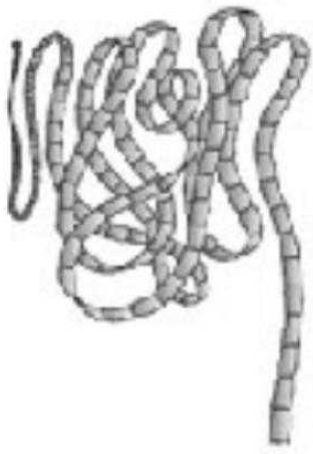
A. Sycon - Porifera
B. Aurelia - Coelenterata
C. Pleurobrachia - Ctenophora
D. Tapeworm - Platyhelminthes
Answer : D

A. Sycon - Porifera
B. Aurelia - Coelenterata
C. Pleurobrachia - Ctenophora
D. Tapeworm - Platyhelminthes
Answer : D
49. Which of the following is a living fossil?
A. Balanoglossus
B. Echinus
C. Ancylostoma
D. Limulus
Answer : D
A. Balanoglossus
B. Echinus
C. Ancylostoma
D. Limulus
Answer : D
50. Which of the following is an incorrect statement regarding flatworms ?
A. They are acoelomates.
B. They are bilaterally symmetrical.
C. They lack a digestive system.
D. They have a circulatory system.
Answer : D
A. They are acoelomates.
B. They are bilaterally symmetrical.
C. They lack a digestive system.
D. They have a circulatory system.
Answer : D
Sharing is caring
Related Post
1000+ Engineering Mechanics MCQ for FCI Recruitment [Solved]
SSC CHSL - Indian History 1000+ MCQ [Solved] PDF Download
UPSC CDS - WAN 1000+ MCQ [Solved] PDF Download
Advance DBMS 1000+ MCQ with answer for RRB JE
Articles 1000+ MCQ with answer for ISRO Recruitment
1000+ Urology Basic Science MCQ for CTET [Solved]